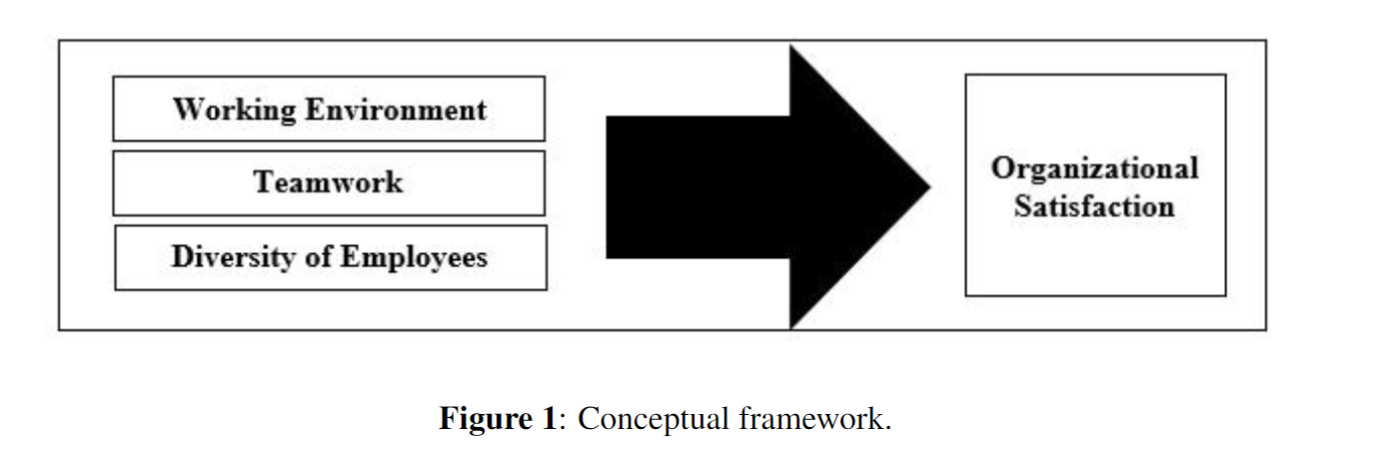Effects and relationships of working environment, teamwork, and diversity to organizational satisfaction
Main Article Content
Abstract
For operating an organization, several mechanisms play at hand. These mechanisms contribute to reaching the organization's end goal for itself and its constituents. This study aims to analyze the working environment, teamwork, and diversity of employees and its relationship to organizational satisfaction from a local higher education institution in Central Luzon, Philippines. The study used descriptive-correlational research with the survey as the primary instrument for data gathering. Eighty-five (85) respondents took part in the survey using a purposive sampling technique. Also, the researcher used an adapted and modified questionnaire to gather pertinent data for the study. This study used SPSS 20 to compute and analyze the gathered data with the following statistical tools: frequency, percentage, mean, t-test, ANOVA and Pearson-r. For the result, the study found that the respondents have a pleasant working environment, ideal teamwork, and diversity in the workplace. This is based on the agreement of the respondents on most of the statements in the survey. Also, the respondents are satisfied with the organization. There were significant differences found in the work environment, teamwork, and diversity when classified according to their demographic profile. Furthermore, there were also significant relationships between work environment, teamwork, diversity, and organizational satisfaction. Based on the preceding results, the researcher provided pertinent recommendations at the end of the study.
Article Details

This work is licensed under a Creative Commons Attribution-NonCommercial-NoDerivatives 4.0 International License.
References
N. Alfiyah, S. Riyanto, The e ect of compensation, work environment, and training n employees’ performance of Politeknik LP3I Jakarta, International Journal of Innovative Science and Research Technology 4 (5) (2019) 947 – 955.
S. Hartinah et al., Teacher’s performance management: The role of the principal’s leadership, work environment, and motivation in Tegal City, Indonesia, Management Science Letters 10 (2020) 235 – 246.
B. Budie et al., Employee satisfaction with the physical work environment: The importance of a need-based approach, International Journal of Strategic Management 23 (1) (2019) 36 – 49.
A. Nanda, The effect of the psychological work environment and workloads on turnover interest, work stress as an intervening variable, Advances in Economics, Business, and Management Research 120 (2019) 225 – 231.
T. Chakraborty, M. Ganguly, Crafting engaged employees through positive work environment: Perspectives of employee engagement, Management Techniques for Employee Engagement in Contemporary Organizations (2019) 1 – 19.
E. P. M. Brouwers et al., To disclose or not to disclose: A multistakeholder focus group study on mental health issues in the work environment, Journal of Occupational Rehabilitation 30 (2019) 84-92.
S. Dion, Leadership development in a virtual work environment, Master’s Thesis, University of Southern Maine, 2019.
Q.H. Vuong et al., Effects of the work environment and collaboration on research productivity in Vietnamese social sciences: evidence from 2008 to 2017 Scopus data, Studies in Higher Education 44(12) (2019) 2132 – 2147.
Y. Don, School management and leadership: Teamwork in schools, Multidisciplinary Journal of Instruction 1(2) (2019) 14-36.
M. K. Aitken, Improving staff communication and teamwork at a psychiatric day program, Doctoral Dissertation, University of Maryland, 2019.
E. Salas et al., Can teamwork promote safety in organizations?, Annual Reviews of Organizational Psychology and Organizational Behavior 7 (2020) 283 – 313.
S. Kundu et al., Perceived workforce diversity and firm performance: A study of an Indian public sector organization, Journal of Strategic Human Resource Management 8(1) (2019) 46 – 60.
A. A. Adeniji et al. From job satisfaction to organizational commitment: The mediating influence of perceived treatment of diversity among Nigeria’s public healthcare employees, Open Access Macedonia Journal of Medical Sciences 7(12) (2019) 2031 – 2035.
M. Dennisen et al., Rethinking diversity management: An intersectional analysis of diversity networks, Organizational Studies 41(2) (2020) 219 – 240.
A. S. Karim et al., Managing workforce diversity in multicultural organizations: Some observations, Journal of European Studies 35(1) (2019) 79 – 91.
L. O. Ebede, Antecedents and outcomes of managing diversity in a UK context: Test of a mediation model, The International Journal of Human Resource Management 30(18) (2019) 2605 – 2627.
G. Azmat, Gender diversity in teams, IZA World of Labor 29(2) (2019) 1 – 10.
M. Dennisen et al., Diversity networks: Networking for equality?,British Journal of Management 30(4) (2019) 966 – 980.
A. Jaiswal, L. Dyaram, Towards well-being: role of diversityand nature of work, Employee Relations 41(1) (2019) 158 – 175.
A. Hayat et al., Mediating effect of human capital on organizational culture, teamwork, organizational development, and organizational commitment, Journal of Social Sciences and Humanity
Studies 5(3) (2019)1 – 9.
E. Vella, S. McIver, Reducing stress and burnout in the publicsector work environment: A mindful meditation pilot study, Health Promotion Journal of Australia 30 (2) (2019) 219 – 227.
L. T. Tuan et al., Addressing employee diversity to foster their
work engagement, Journal of Business Research 95 (2019) 303
– 315.
C. Wilson et al. . School environment and mastery experience as predictors of teachers’ self-ecacy beliefs towards inclusive teaching. International Journal of Inclusive Education 24(2) (2020) 218 – 234.
C. Wohlers et al., The relation between activity-based work environments and oce workers’ job attitudes and vitality, Environment and Behavior 51(2) (2019) 167 – 198.
A. Alsayyari et al., A conceptual framework for facility management in higher education institutions in Saudi Arabia, TEM Journal 1 (2019) 157 – 164.
R. V. D. Gonzale, T. M. Melo, Analyzing dynamic capability in teamwork, Journal of Knowledge Management 23(6) (2019) 1196 – 1217.
A. Risberg, S. S. Gottlieb, Workplace diversity and gender in merger and acquisition research, C. L. Cooper and S. Finkelstein (Ed.) Advances in Mergers and Acquisitions, Emerald Publishing Limited, 2019.
M. O. S. Abaker et al., Organizational policies and diversity management in Saudi Arabia, Employee Relations 41(3) (2019) 454 – 474.
K.Redelinghuys, S. Rothmann, E. Botha, Flourishing-atwork: The role of positive organizational practices, Psychological Reports 122 (2) (2019) 609 – 631.


